
Hew Locke (British, b. 1959). El Dorado, 2005. Mixed media, 1141⁄4 x 687⁄8 x 235⁄8 in. (290 × 175 × 60 cm). West Collection, Oaks, Pennsylvania (Photo: FXP Photography)

Hew Locke (British, b. 1959). El Dorado, 2005. Mixed media, 1141⁄4 x 687⁄8 x 235⁄8 in. (290 × 175 × 60 cm). West Collection, Oaks, Pennsylvania (Photo: FXP Photography)
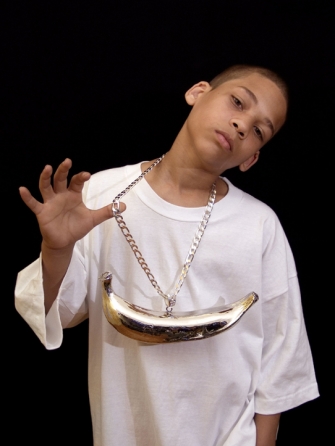
Miguel Luciano (b. Puerto Rico1972; works in United States). Platano Pride, 2006. Chromogenic print, 40 × 30 in. (101.6 × 76.2 cm). Courtesy of the artist
Artist Statement
My work addresses playful and painful exchanges between Puerto Rico and the United States. I am interested in examining how colonial subordination is extended through globalization as communities have shifted gears from a production-based society to one that is grounded in consumption. My work often organizes popular, religious, and consumer iconography into fluctuating new hierarchies to describe the hybridity of contemporary belief systems.
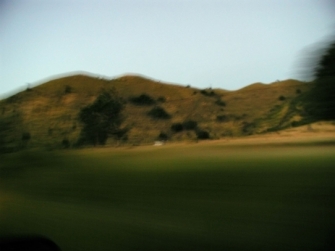
Deborah Jack (b. Netherlands 1970; works in United States). T/here, 2003–6. Digital prints, 21 × 84 in. (53.3 × 213.3 cm) overall. Courtesy of Diaspora Vibe Gallery, Miami, Florida (Photo: Courtesy of the artist)
Artist Statement
T/here represents my multiple modes of existence/being and my constant shifting of the concept of home. The images deal with the fracturing of home space that occurs in the Diasporic body. Home, not as a geographical space but as one of shifting memory/memories, where the dynamics between the private/public, the interior/exterior, and the familiar/foreign are ones of negotiation and compromise. In this scenario my body becomes a site for this flux-and-flow experience, which finds the home space somewhere in between.

Nicole Awai (b. Trinidad 1966; works in United States). Specimen from L.E. (Local Ephemera): Resistance with Black Ooze, 2005. Graphite, acrylic paint, nail polish, and glitter on paper, 52 × 58 in. (132.1 × 147.3 cm). Courtesy of the artist (Photo: Jason Mandella)
Artist Statement
I am focused primarily on two things, multiplicity of perspective (the many at once) and the elasticity of time . . . which stretches and bounces back and forth in our complex, collective human psyche. History dissolves, evaporates, and reconstitutes constantly and all at once, making the postcolonial predicament immediate and ephemeral, distant and perpetual. The shift space, the ooze, the place in between, is where meaning is elucidated and compounded all at once.
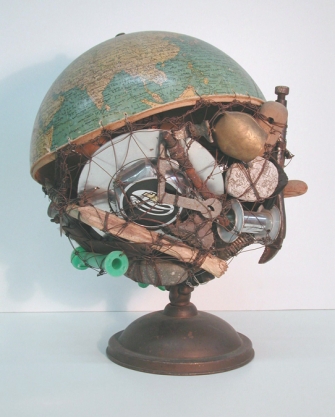
Arthur Simms (b. Jamaica 1961; works in United States), and Peter Orner (b. United States 1968). Globe: The Veld, 2004. Mixed media, 17 × 14 × 14 in. (43.2 × 35.6 × 35.6 cm). Courtesy of the artist
Artist Statement
Over the past decade, I have been working on a body of work that evokes memory, loss, and cross-cultural ties. The work as a group, through object and thought, embodies power and history. Through their formal rigor and the poetic associations that the recycled elements trigger, the sculptures narrate stories of personal identity, family, spiritual and physical journeys, erotic tensions, and nostalgia for home.
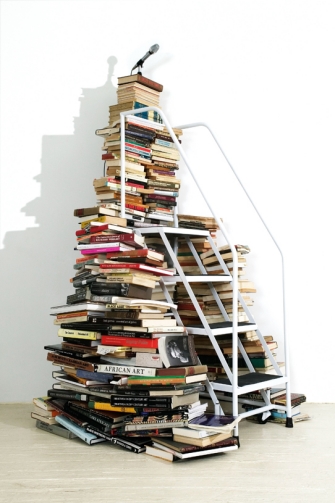
Satch Hoyt (b. United Kingdom 1957; works in United States). Say It Loud!, 2004. Five hundred books, white metal staircase, and microphone with four speakers, wall text; dimensions variable. Courtesy of the artist
Artist Statement
My practice at the present time aims to engage the viewer on a multi-sensory platform in an almost theatrical mise en scène. Using sound as the unifying tangent plane that binds together my multidimensional practice, I create layered works that investigate race and identity via popular cultural icons.
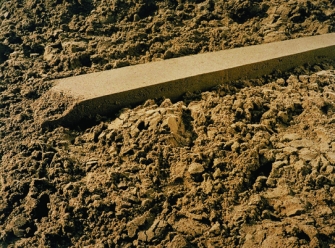
Liset Castillo (b. Cuba1974; works in United States). Departure Point I, 2003. Chromogenic print, 491⁄2 x 65 in. (125 × 165 cm). Courtesy of the artist and Black & White Gallery, Brooklyn, New York
Artist Statement
The notion of movement, with which the work plays, offers a reading of the historic relationship between nature and artifice. It’s for this reason that it is not the object that becomes the work, but rather its representation, the photograph as a symbol of the documentation, which offers itself to the spectator as testimony of the utopia that in the end lives only as image, in the process of disappearing.
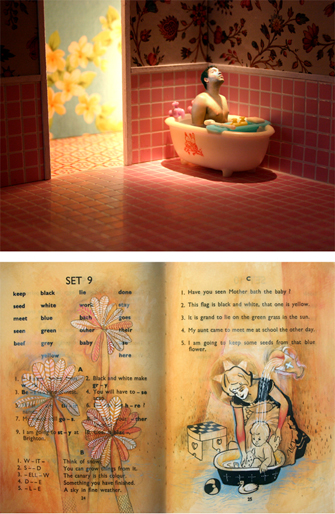
Ewan Atkinson (b. Barbados 1975). You Will Have to Use Soap, 2005. Digital print and mixed media, 241⁄2 x 16 in. (62.2 × 40.6 cm). Collection of Judilee Reed, Brooklyn, New York (Photo: Courtesy of the artist)
Artist Statement
The relationship between personality and space has always fueled my work. What factors have tied us to an identity? What choices have we been able to make in creating this aesthetic? I explore my own questions of identity, its influences and its limitations within a Caribbean society.
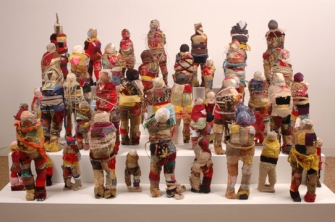
Alex Burke (b. Martinique 1944; works in France). The Spirit of Caribbean, 2006. Forty-seven dolls; fabric and other materials, dimensions variable. Courtesy of the artist (Photo: Franck Girier Du Fournier)
Artist Statement
Working from memory and historical narratives has been a way to question my “collective memory,” to summon the constituent elements of the Caribbean identity. I have tried to make that confused past become visible; I have placed objects together and created a world of odds and ends. That is the very characteristic of the Caribbean: building up on a field of ruins, fertilizing a field of corpses, patching things up, making treasure of nothing.
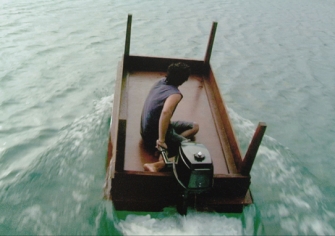
Jennifer Allora (b. United States 1974; works in Puerto Rico) and Guillermo Calzadilla (Cuban, b. 1971; works in Puerto Rico). Under Discussion, 2005. Single-channel DVD, color, sound, 6 min. 14 sec. Courtesy of the artists and Galerie Chantal Crousel, Paris
Artist Statement
One of the things we are looking at is the development and use of the term “landscape” and “landmark”—how these terms are related and how they differ. The term landscape has a long history within the arts—music, literature, the visual arts, and architecture. With landscape, as Vito Acconci has aptly described it, the “land escapes”—it’s that portion of a territory that the eye can comprehend in a single view.
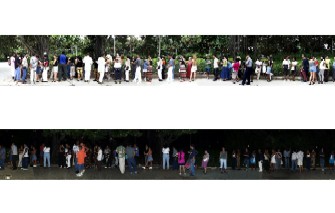
Glenda León (b. Cuba1976; works in Cuba and Germany). Prolongación del deseo (Extension of Desire), 2005. Lambda print, 23⁄8 x 128 in. (5.8 × 325 cm). Courtesy of the artist
Artist Statement
A Cuban reality expanded in time, extending: the Line, a symptom of Revolutionary Cuba. I see the line as an extension of desire of the person waiting to get the anticipated thing. The longer the waiting is, the bigger the projection of the desired object must appear in the person’s head; otherwise it would be very easy to lose patience.
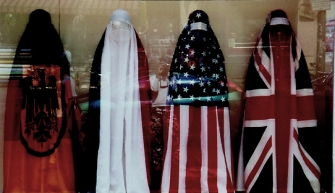
Jean-Ulrick Désert (b. Haiti; works in Germany and United States). The Burqa Project: On the Borders of My Dreams I Encountered My Double’s Ghost, 2002. Mannequins and textiles, 63 × 118 in. (160 × 300 cm). Courtesy of the artist
Artist Statement
Francis Bacon is quoted as saying “The job of the artist is to deepen the mystery.” In this and my other works, through the use of conspicuous invisibility and the transparency of shared associations, the mystery remains elusive. My works may be viewed as a desire to reconstruct and defy fixed identity in my artistic practice, to be “present” and to be “invisible” by choice and by circumstance.
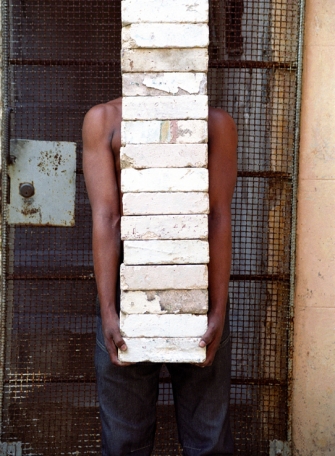
Alexandre Arrechea (b. Cuba1970). Elementos arquitectónicos I (Architectural Elements I), 2004. Chromogenic print, 431⁄4 x 311⁄2 in. (110 × 80 cm). Courtesy of the artist and Magnan Projects, New York
Artist Statement
My special interest is urbanism—life in, around, and within city structures. . . . My work with the architectonic spaces has gone through several phases. I have tried to activate dead zones of the city. In other works, I have created transportable cities with social implications. More recently I have worked with closed-circuit cameras that are used in surveillance programs.
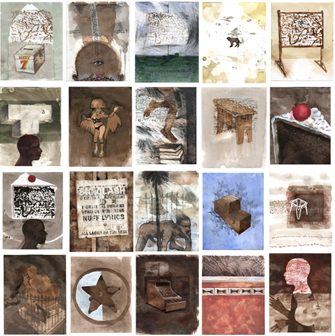
Christopher Cozier (b. Trinidad 1959). Tropical Night, 2006–present. Ink, pencil, stamps. Two hundred drawings, each 9 × 7 in. (22.9 X 17.8 cm). Courtesy of the artist
Artist Statement
I am investigating my voice and voicelessness simultaneously. . . . I am very wary of narrative as it often feels like an imposition on experience, a rationalization that inhibits as much as it offers consolation or promises order or meaning. Over time, I have begun to understand or accept that the conceptual process itself became the actual work. I began to call it my “cultural autopsy.”
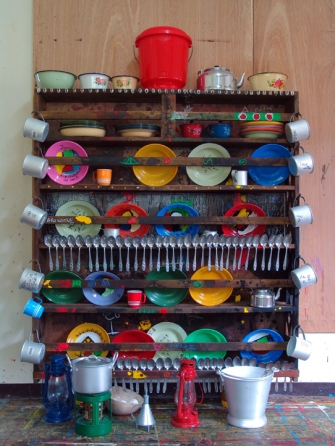
Marcel Pinas (b. Suriname 1971). Kuku (Kitchen), 2005. Plastic plates, aluminum spoons, cups, wood shelves; 59 × 59 × 85⁄8 in. (150 × 150 × 22 cm). Courtesy of the artist
Artist Statement
I think that it is very important to keep the culture alive through art by using symbols, signs, objects that have been used by the Maroon populations. For example, the Afaka sign has been used to protect the spoons that symbolize the Maroon community while also transforming the object into art.

Storm Saulter (b. Jamaica 1983). Waterboot, 2003. Single-channel DVD, color, sound, 2 min. 25 sec. Courtesy of Palm Pictures
Artist Statement
In a place where people cannot afford to create their identity through consumerism and conspicuous consumption, they must create identity from the inside out—suffering, rejoicing, working hard to survive, and living a real life. I believe this is why Jamaicans are so proud, unique, and fearless. This is why they are the inspiration for everything I do. My homeland is integral to my work. I retell these captured stories, exaggerating the most potent moments using repetition or playing with motion.
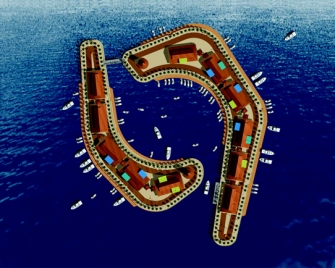
Colectivo Shampoo (Dominican Republic). D’ La Mona Plaza (The Mona Mall), 2004. Inkjet prints and single-channel DVD, color, sound; each print 40 × 40 in. (101.6 × 101.6 cm). Courtesy of Colectivo Shampoo: Maurice Sánchez, Angel Rosario, Miguel Canaán
Artist Statement
Bringing the illegal trips toward Puerto Rico in El Canal de la Mona together with the Dominican habit of stopping for certain activities in los paradores along the freeways, D’La Mona Plaza is a project that tries, through absurdity, to denounce these tragedies.

Jorge Pineda (b. Dominican Republic 1961). Mambrú, 2006. Nine figures; cedar wood, lead, fabric; each 60 × 4 × 8 in. (152.4 × 10.2 × 20.3 cm). Courtesy of the artist
Artist Statement
Childhood is the time when we start to build up our personality, and it is supposed to be the happiest time of our lives, but social violence makes it difficult to adjust. In order to be strong, children make masks where they can hide fear, so they can play with the negative idea they have of themselves. These masks shield the feelings reflected in society as I show in Mambrú, with its child soldiers who have been taken away and used as instruments of destruction.
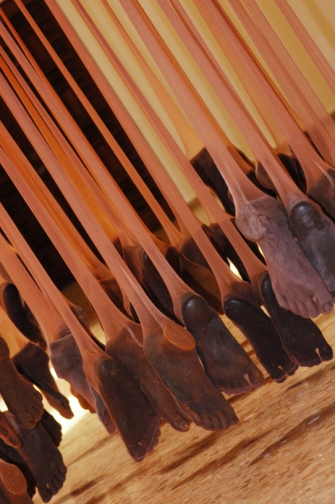
Raquel Paiewonsky (b. Dominican Republic 1969). Levitando: A un solo pie (Levitating: On One Foot), 2003. Panty hose, beeswax, cable, 1181⁄8 x 1181⁄8 x 1571⁄2 in. (300 × 300 × 400 cm). Courtesy of the artist (Photo: Ruy Dos Santos)
Artist Statement
In recent years, possible bodily mutations have inevitably become the main focus of my work. This allows me to experiment with new ways of merging elements of urban life, gender stereotypes, and stress with nature, spirituality, and instinct. In other words, through this sort of visual laboratory I can take a closer look at our postmodern world, and I can take to its utmost limits that most amazing human trait of adaptability.
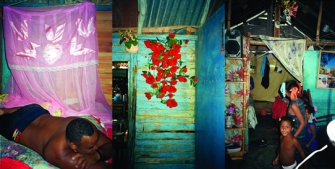
Polibio Díaz (b. Dominican Republic 1952). Después de la siesta (After the Siesta), 2002–5, from the Interiors series. Chromogenic print, 59 × 1181⁄8 in. (150 × 300 cm). Courtesy of the artist
Artist Statement
My art is oriented first to my fellow Dominicans, so we recognize and accept ourselves as we are: the wonderful complex mixture of several civilizations with their shades of color reflected in the complexity of our skin and culture. By making images of black and mulatto subjects the basis of my work, I challenge the aesthetic Greco-Latin codes on which we pretend to base the concept of Dominican beauty.
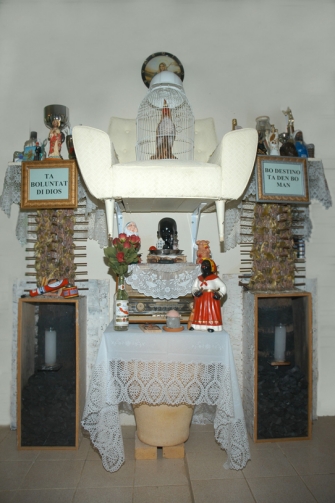
Tirzo Martha (b. Curaçao 1965). Spirit of the Caribe, 2005. Mixed-media installation, dimensions variable. Courtesy of the artist
Artist Statement
My work is an existential analysis of our contemporary Caribbean societies—societies that are still afraid to free themselves from the burden created in the past. It’s about the material fiction that coexists with the spiritual reality. We are experiencing a transitory existence in our transitory societies that gives birth to my transitory works.
Infinite Island: Contemporary Caribbean Art
August 31, 2007–January 27, 2008
Infinite Island presents some eighty works made in the last six years that reflect the region’s dynamic mix of cultures, its diasporas, and its socio-political realities, all of which are constantly transforming themselves. The forty-five emerging and established artists, who work both in the Caribbean and abroad, represent multiple perspectives as they explore the complexities of Caribbean history and identity. Including painting, sculpture, photography, prints and drawings, video, and installation, the exhibition is grouped around themes that encompass history, memory, politics, myth, religion, and popular culture.
The exhibition is curated by Tumelo Mosaka, Associate Curator of Exhibitions at the Brooklyn Museum.
Sponsored by Forest City Ratner Companies.
The exhibition is made possible by the Martha A. and Robert S. Rubin Exhibition Fund and the Barbara and Richard Debs Exhibition Fund. Generous support is contributed by the Peter Norton Family Foundation, the American Center Foundation, and the National Endowment for the Arts. Additional funding is contributed by the Friends of Brooklyn Museum, the Mondriaan Foundation, Amsterdam, and the Consulate General of the Netherlands.
The accompanying catalogue is supported by a Brooklyn Museum publications endowment established by the Iris and B. Gerald Cantor Foundation and the Andrew W. Mellon Foundation.
Media sponsor

